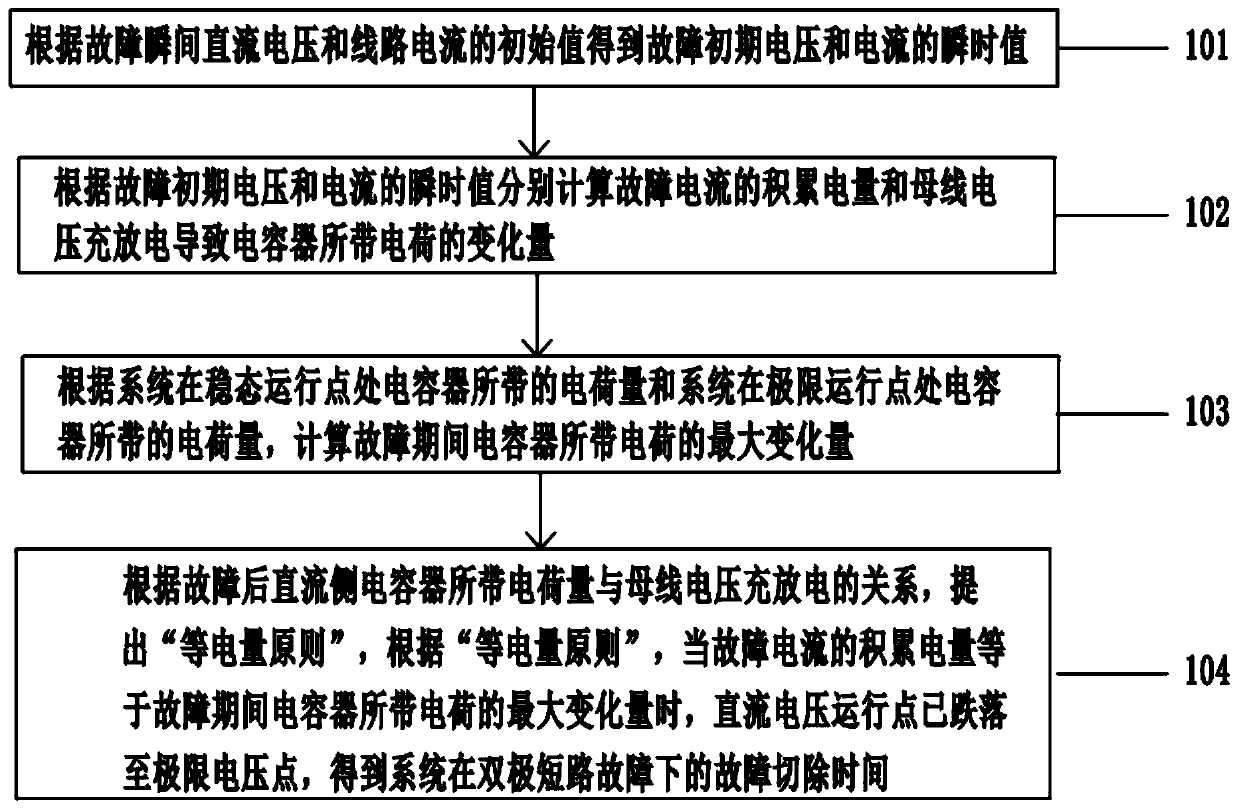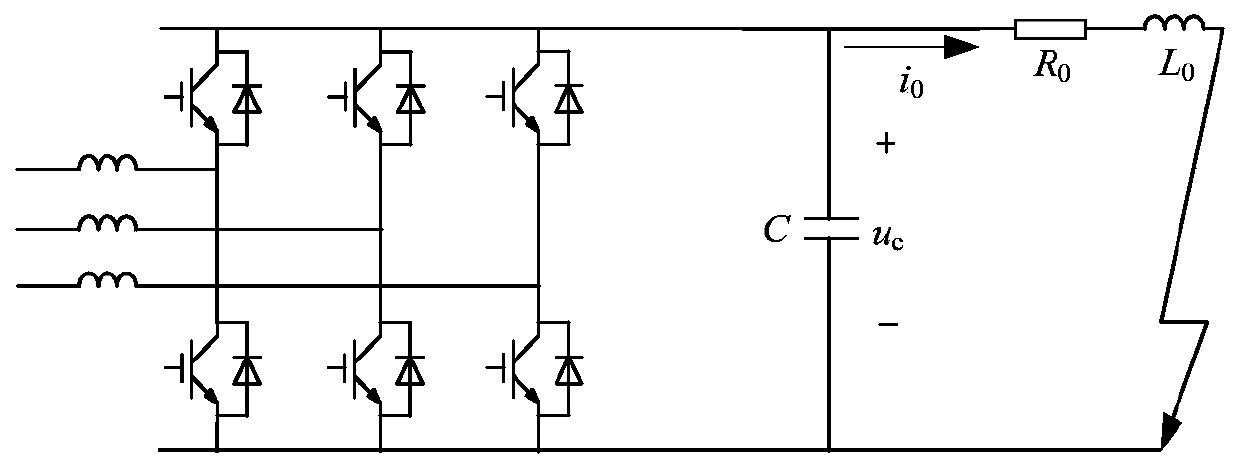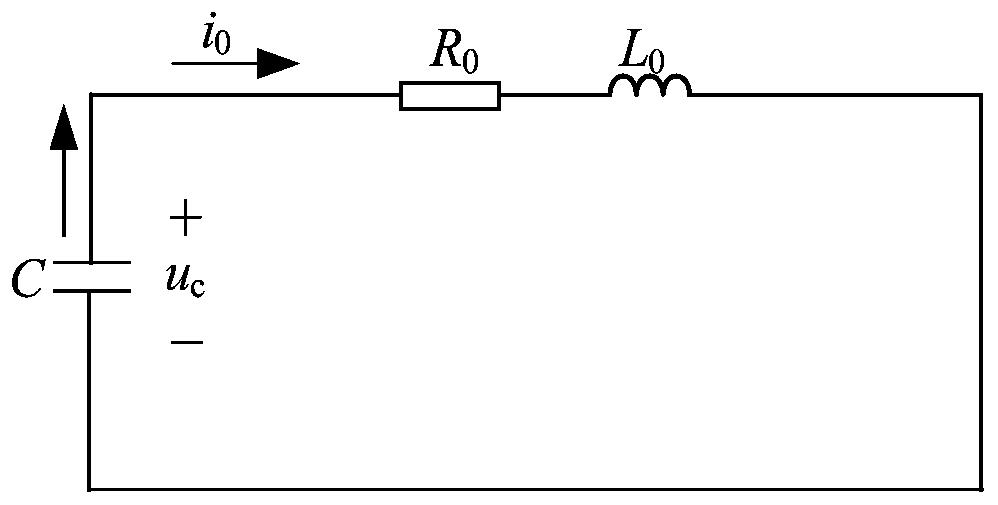Method for determining fault removal time of flexible direct current power grid under bipolar short circuit
A bipolar short circuit and fault removal technology, applied in circuit devices, emergency protection circuit devices, electrical components, etc., can solve the problems of system safety hazards, large fluctuations in DC bus voltage, low inertia of flexible DC power grids, etc., and reduce the operating speed. requirements, delayed action time, safety and effect of stable voltage sag margin
- Summary
- Abstract
- Description
- Claims
- Application Information
AI Technical Summary
Problems solved by technology
Method used
Image
Examples
Embodiment 1
[0103] The present invention builds such as in Matlab / Simulink environment Figure 6 The simulation model of the two-terminal flexible DC grid is shown. On the power supply side, the power frequency three-phase AC power supply is filtered and transformed, and then connected to the VSC1 converter to connect to the DC power grid. The voltage at both ends of the parallel capacitor C represents the DC bus voltage. On the load side, the duty ratio of the converter VSC2 is adjusted to ensure that the connected load exhibits constant power characteristics. The basic parameters of the simulation model are shown in Table 1.
[0104] Table 1 Basic parameters of flexible DC grid
[0105]
[0106] It can be seen from Table 1 that when the system runs stably, U b =500V, I b = 40A, P 0 =20kw, line equivalent resistance R L =5.8Ω, DC side parallel capacitance C=3mF. by the formula The operating point voltage U of the system limit voltage can be obtained cmax is 340V. At the sam...
Embodiment 2
[0115] After the flexible DC grid runs stably, the bipolar short-circuit fault of the system is simulated through the simulation model. At the initial moment, the system runs stably at 498V with a 20kw constant power load. After 0.02s, a bipolar short-circuit fault occurs, the capacitor discharges, and the bus voltage drops. When the fault is removed at different times, the response result of the system is as follows: Figure 9 shown.
[0116] When a bipolar short-circuit fault occurs, at four different times (t a = 0.025s, t b = 0.028s, t c = 0.03s and t d =0.031s) to remove the fault, the response result is as follows Figure 9 shown. at t a , t b and t c The short-circuit fault is cut off at all times, and the DC bus voltage drops to 470V, 375V and 342V respectively. With the recovery of the fault, the system in the first two working conditions resumes stable operation, the system in the third working condition runs stably at 360V, and the system in the fourth work...
Embodiment 3
[0118] system at different fault parameters R 0 , L 0 Under , the simulation changes of DC bus voltage and fault removal time are as follows: Figure 10 shown.
[0119] With the system equivalent failure parameter R 0 , L 0 change, the fault removal time t 1x The simulated values are shown in Table 3.
[0120] Table 3 Simulation values of fault removal time under different parameters
[0121]
[0122] For the flexible DC grid with given fault parameters, the fault removal time t obtained by simulation is 1x Compared with the theoretically calculated values (shown in Table 2), the error results are shown in Table 4.
[0123] Table 4 Error value of fault removal time under different parameters
[0124]
[0125] It can be seen from Table 4 that under the four different fault parameters, as the fault removal time prolongs, the error percentage between the theoretical and simulation values of the system gradually decreases, and the accuracy of the theoretical ...
PUM
 Login to View More
Login to View More Abstract
Description
Claims
Application Information
 Login to View More
Login to View More - R&D
- Intellectual Property
- Life Sciences
- Materials
- Tech Scout
- Unparalleled Data Quality
- Higher Quality Content
- 60% Fewer Hallucinations
Browse by: Latest US Patents, China's latest patents, Technical Efficacy Thesaurus, Application Domain, Technology Topic, Popular Technical Reports.
© 2025 PatSnap. All rights reserved.Legal|Privacy policy|Modern Slavery Act Transparency Statement|Sitemap|About US| Contact US: help@patsnap.com



